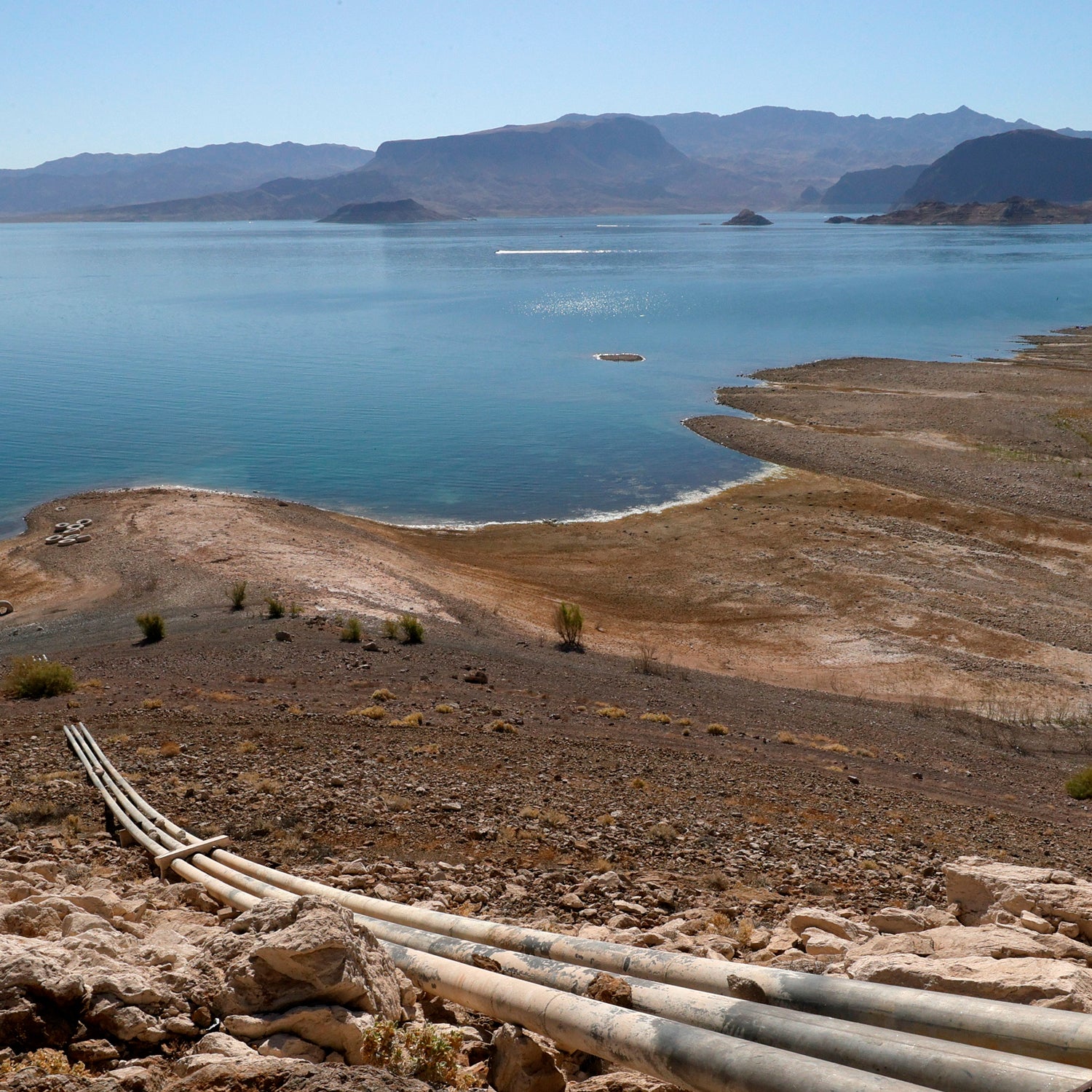“So just a heads-up,” said my friend Ted, who was shin-deep in the icy snowmelt of Colorado’s Roaring Fork River. “We hit the first Class III pretty quick around the corner.” He pushed off in his kayak, and I paddled close behind, planning to follow him into the first big wave train.
But instead, when we rounded the corner and the river dropped elevation, we scraped our boats over rocks and pivoted through skinny channels. “Huh, I guess there’s not much there at this level,” he said. The river, which is usually raging this time of year, was barely braiding through its bed. We knew it was low, but we didn’t know how grim it actually was until we were in it.
I spent runoff season this year chasing whitewater along the spine of the Rockies, where the impacts of a long-range megadrought feel increasingly painful and obvious. More than half of the western United States is currently experiencing extreme drought, according to the , and it’s rapidly .
Although the Mountain West’s ����-���dzܲԳٰ��������ԴǷɱ貹����—the source of water for a wide swath of land on both sides of the Continental Divide—was around 80 percent of its average this winter, the past 12 months have been among the hottest and there. As the snow melted, runoff was soaked up by parched soils, which are still dry from last year’s monsoon-free summer and . When it’s as hot as it has been, every living thing needs more water, so plants sucked in moisture, too. In the same area of the mountains where the snow was 80 percent, river flows 30 percent of their average. Ted was right: there’s not much water when there’s this level of aridity.
Paddling, for me, is a benchmark, a tangible way to understand what all those and numbers mean. And these days, the bottom-scraping springtime runs feel like a creepy indicator of how bad things will be downriver, where those waterways are used to grow food, maintain ecosystems, fight wildfires, and provide drinking water. I paddled Westwater Canyon on the Colorado River in Utah while it was running at one-tenth of its average flow, and I checked in on the formerly known as the Dolores River—a sight that made my stomach drop. On the other side of the Divide, I took a turgid run down Browns Canyon on Colorado’s Arkansas River—the most heavily commercially rafted section of river in the nation—and winced watching the guides trying to keep their clients paddling through the slack water, which was flowing well below the midsummer dam-released minimum of 700 cubic feet per second. It’s the scariest year I’ve ever been a river runner, and I’m not alone in thinking that.
“I’m nervous looking forward. It’s wishful thinking to assume it will get better,” says Eric Kuhn, former general manager of the Colorado River District and coauthor of . Kuhn has worked in water management for decades and believes the way we’re currently managing rivers and hasn’t been for a while. It’s coming to an inflection point where things will really have to change.
The signs (like dry rivers) and symptoms (the wave of ) are cascading on top of each other. In 2019, I wrote a book called Downriver about water policy with a subtitle that now feels painfully flippant: “Into the future of water in the West.” That was two years ago. Now the future is here—hotter, drier, sooner than predicted, and scarier than imagined.
We can’t call these climatic conditions a drought anymore, because that implies it will end.
By June 1, snowpack in the Sierra Nevada was at , and California’s governor had declared a drought emergency in two-thirds of the state’s counties. After a record-breaking fire year in 2020, wildfire risks were already high, and the state’s agriculture industry, which supplies a huge amount of the country’s veggies, fruits, and nuts, was facing shortages and cutting crops to compensate. In Oregon, fragile, threatened salmon because streams and lakes are drying up. Wide swaths of northern New England and the upper Midwest are abnormally dry. Even is at elevated risk for wildfires.
In the Colorado River Basin—a bellwether for dryland watersheds because it’s crucial to millions of people and drying fast—the two big reservoirs in the system, Lake Powell and Lake Mead, are crashing toward their lowest levels ever and approaching elevations that will trigger the first-ever federally mandated . In other words, states, starting with Arizona, will have to start taking less from reservoirs than they’ve historically been legally promised.
A few glaring reasons indicate why we’re at this tipping point. The first is that we’re not operating within our limits. The Colorado River, for example, has been overallocated since the Colorado River Compact was signed in 1922. The agreement, often referred to as the law of the river, gave the seven states in the basin more water than exists in the river. Brad Udall, senior water and climate-research scientist at Colorado State University, we’ve been using 1.2 million acre-feet of water more than the river’s natural flow each year, which is one of the reasons why the reservoirs are plummeting. We’re also continuing to in dry places and as we do.
And we’re ignoring scientific limits and increasing demand while climate change is shrinking our supply even further. “This is the new baseline, and there’s no more water left in the system,” Kuhn says. According to a coauthored by Udall, we can attribute at least half of the decline in water supply to greenhouse-gas-related warming. For every one degree Celsius of warming, he expects another 9 percent decline in the Colorado’s flow, and similar patterns are showing up in rivers globally.
We know that the supply is shrinking, and now the huge, complicated challenge is changing the way we operate within those limits. Kuhn believes that Mead and Powell are test cases for whether we can adapt to climate change, and what the realities are of doing that. He points out that we can’t call these climatic conditions a drought anymore, because that implies it will end. Years are variable, and snowpack, rainfall, and temperatures oscillate, but we have to look at the science and assume that the hot, dry trends we’re seeing will continue—and continue to get worse.
And then we have to get realistic about cutbacks. Demands have to shrink along with supply.
Part of that is reliant on state, tribal, and federal water managers, who are responsible for allocation. Right now on the Colorado River, those entities are renegotiating what are called , which outline the water levels that trigger those planned cutbacks and delineate which places have to sacrifice water first. Last year a voluntary set of shortages, called the , was put in place as a stopgap to keep the river from spiraling into crisis.
As the water managers come up with the next set of guidelines, which are slated to go into place in 2026, they’ll have to be much stricter, while also trying to be equitable. It’s going to be extremely difficult, because these decisions are tangled up in states’ rights, environmental equity, and philosophies about growth. Kuhn says he hopes desperation might drive more concession and collaboration than there’s been before. As those negotiations and cutbacks happen on the Colorado—which brings water to 40 million people in the western U.S.—they can be a template for other rivers and other dry places that are facing similar conditions.
�����ԹϺ��� of water management, Kuhn has two simple directives to address water scarcity: stop growing unnecessary grass, and cut back on carbon use. Those steps are slowly starting—Nevada just passed a law banning —but we have to work on the carbon thing individually, nationally, and internationally if we want the future of our water supply to be anything close to the past.
You can already sense the drought from the rivers this spring, and as this year’s snowpack flows downstream, I’m sure we’re going to feel the impacts of heat and drought and fire in so many other ways. At this point, we can only assume it’s going to get worse unless we start to conserve and cut back now.


